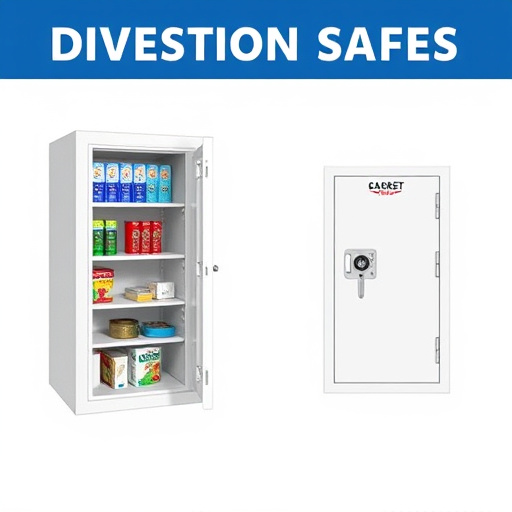Diversion safes offer a unique way to secure valuables by disguising them as everyday items like books or fake rocks, making them nearly invisible to intruders. When hiding these safes, get creative with placement, integrating them among regular household objects for maximum concealment and easy access. Avoid common hiding spots and consider locations like faux electrical panels or the back of a closet. Regularly review and update hiding spots, staying ahead of potential threats, and implement additional security measures for optimal protection.
“Uncover the ultimate secret weapon for home security with discreet safe solutions—a hidden sanctuary within your household. This article explores innovative ways to protect valuable items by integrating ‘diversion safes’ into your living space. From understanding the concept to creative placement ideas, we guide you through choosing the perfect disguised safe and securing it in a location where only you know. Discover where to hide diversion safes in plain sight, ensuring peace of mind with this clever and effective security measure.”
- Understanding Diversion Safes: A Secretive Solution for Security
- Creative Placement: Discreet Spots in Your Home for a Safe
- Choosing the Right Disguised Safe: Features and Considerations
- Enhanced Security: Tips for Securing Your Hidden Treasure
Understanding Diversion Safes: A Secretive Solution for Security
Diversion safes are a clever and discreet way to secure valuable items within your home, offering an innovative solution for those seeking enhanced security. These safes are designed to look like common household objects, such as books, fire extinguishers, or even fake rocks, making them virtually unnoticeable to the untrained eye. The key to their effectiveness lies in the concept of diversion—redirecting attention away from the actual safe and towards something seemingly innocuous.
When considering where to hide a diversion safe, creativity is essential. Think beyond traditional hiding spots like under the bed or in a closet. These safes can be placed among your everyday items, for instance, a bookcase filled with books (but with a hidden compartment), a kitchen cabinet containing fake rocks (with a secret stash inside), or even integrated into a wall as an artistic piece. The location should provide both accessibility for you and concealment from potential intruders, ensuring your valuables remain secure while appearing entirely ordinary.
Creative Placement: Discreet Spots in Your Home for a Safe
When considering where to hide a diversion safe, creativity is key. Think beyond the obvious and explore less suspected areas within your home. For instance, a faux electrical panel box or a fake vent can provide an excellent cover for a small safe. These spots are not only out of sight but also easily accessible during an emergency.
Consider also incorporating everyday items as potential hiding places. A well-disguised book safe or a hidden compartment within a decorative piece can offer a subtle solution. Even a seemingly innocuous potted plant could house a secure compartment, making it an unlikely place for someone to look. This strategic placement ensures the safety of your valuables while maintaining an unassuming atmosphere in your home.
Choosing the Right Disguised Safe: Features and Considerations
When selecting a disguised safe, consider your specific needs and where you plan to hide it. These safes come in various forms, from looking like common household items to replica art pieces. For discreet storage, choose a safe that blends seamlessly with its surroundings. For instance, a booksafe is an excellent option for hiding valuables within a collection of books on your shelf. Similarly, a wall-mounted fake electric outlet can provide hidden security for smaller items.
When deciding on the right location, think about high-traffic areas or places less suspected by intruders. Kitchens, bathrooms, and hallways are common spots but remember, the key is to choose a spot that makes the safe appear insignificant and out of place. Additionally, consider factors like accessibility—you want easy access during emergencies while ensuring it’s secure from unauthorized users.
Enhanced Security: Tips for Securing Your Hidden Treasure
When choosing a location for your discreet safe disguised as a common household item, consider areas that offer both accessibility and secrecy. Common hiding spots like under the kitchen sink or inside a bookcase might seem obvious to seasoned intruders. Instead, think outside the box—places like the back of a closet, behind a painting, or even within a faux electrical panel can provide better security. The key is to select a spot that’s out of sight yet easily accessible to you.
To enhance your secure setup, implement additional safety measures. Utilize locking mechanisms that match the safe’s disguise—a magnetic lock disguised as a light switch plate or a hidden combination lock integrated into a bookend. Ensure your safe is secured to prevent tampering and consider adding alarms or security cameras nearby for extra peace of mind. Regularly review your chosen hiding place and update it if needed, staying one step ahead of potential intruders.
Incorporating a discreet safe into your home, disguised as a common household item, offers an innovative and secretive solution for enhanced security. By understanding diversion safes and strategically choosing their placement, you can safeguard valuable items while keeping them hidden from prying eyes. Remember, the key to successful concealment is creativity – consider less obvious spots and utilize everyday objects. With the right disguised safe and some thoughtful considerations, you’ll create a secure haven for your treasures, ensuring peace of mind in any home.
